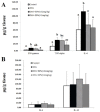A Role of Exopolysaccharide Produced by Streptococcus thermophilus in the Intestinal Inflammation and Mucosal Barrier in Caco-2 Monolayer and Dextran Sulphate Sodium-Induced Experimental Murine Colitis
- PMID: 30708992
- PMCID: PMC6384629
- DOI: 10.3390/molecules24030513
A Role of Exopolysaccharide Produced by Streptococcus thermophilus in the Intestinal Inflammation and Mucosal Barrier in Caco-2 Monolayer and Dextran Sulphate Sodium-Induced Experimental Murine Colitis
Abstract
Exopolysaccharide (EPS) produced by probiotics may play an important role in gastrointestinal disease prevention, including ulcerative colitis. However, there is no literature reporting on the intervention effects of purified EPS. The aim of this study was to investigate the alleviating effect of the purified EPS produced by Streptococcus thermophilus MN-BM-A01 on murine model of colitis induced by dextran sulphate sodium (DSS). A water-soluble heteropolysaccharide (EPS-1) isolated from MN-BM-A01 was composed of rhamnose, glucose, galactose, and mannose in a molar ratio of 12.9:26.0:60.9:0.25, with molecular weight of 4.23 × 10⁵ Da. After EPS-1 administration, the disease severity of mouse colitis was significantly alleviated, mainly manifesting as the decrease of disease activity index and mitigated colonic epithelial cell injury. Meanwhile, pro-inflammatory cytokines levels (tumor necrosis factor-α, interleukin-6, and interferon-γ) were significantly suppressed, the reduced expressions of tight junction protein (claudin-1, occludin, and E-canherin) were counteracted. In addition, the results in vitro showed that EPS-1 protected intestinal barrier integrity from the disruption by lipopolysaccharide in Caco-2 monolayer, increased expression of tight junction and alleviated pro-inflammatory response. Collectively, our study confirmed the protective effects of purified EPS produced by Streptococcus thermophilus on acute colitis via alleviating intestinal inflammation and improving mucosal barrier function.
Keywords: DSS-induced colitis; Streptococcus thermophiles; exopolysaccharide; tight junction protein.
Conflict of interest statement
The authors declare no conflict of interest.
Figures





Similar articles
-
Beneficial effects of nutritional supplements on intestinal epithelial barrier functions in experimental colitis models in vivo.World J Gastroenterol. 2019 Aug 14;25(30):4181-4198. doi: 10.3748/wjg.v25.i30.4181. World J Gastroenterol. 2019. PMID: 31435172 Free PMC article. Review.
-
Effect of toll-like receptor 3 agonist poly I:C on intestinal mucosa and epithelial barrier function in mouse models of acute colitis.World J Gastroenterol. 2017 Feb 14;23(6):999-1009. doi: 10.3748/wjg.v23.i6.999. World J Gastroenterol. 2017. PMID: 28246473 Free PMC article.
-
Coptisine ameliorates DSS-induced ulcerative colitis via improving intestinal barrier dysfunction and suppressing inflammatory response.Eur J Pharmacol. 2021 Apr 5;896:173912. doi: 10.1016/j.ejphar.2021.173912. Epub 2021 Jan 27. Eur J Pharmacol. 2021. PMID: 33508280
-
Protective effect of exopolysaccharide fraction from Bacillus subtilis against dextran sulfate sodium-induced colitis through maintenance of intestinal barrier and suppression of inflammatory responses.Int J Biol Macromol. 2021 May 1;178:363-372. doi: 10.1016/j.ijbiomac.2021.02.186. Epub 2021 Feb 27. Int J Biol Macromol. 2021. PMID: 33652052
-
Evaluation of the Effect of Probiotic Supplementation on Intestinal Barrier Integrity and Epithelial Damage in Colitis Disease: A Systematic Review.Nutr Rev. 2025 Jul 1;83(7):e1782-e1797. doi: 10.1093/nutrit/nuae180. Nutr Rev. 2025. PMID: 39602817 Free PMC article.
Cited by
-
Effect of Probiotics on Respiratory Tract Allergic Disease and Gut Microbiota.Front Nutr. 2022 Feb 22;9:821900. doi: 10.3389/fnut.2022.821900. eCollection 2022. Front Nutr. 2022. PMID: 35295917 Free PMC article. Review.
-
Beneficial effects of nutritional supplements on intestinal epithelial barrier functions in experimental colitis models in vivo.World J Gastroenterol. 2019 Aug 14;25(30):4181-4198. doi: 10.3748/wjg.v25.i30.4181. World J Gastroenterol. 2019. PMID: 31435172 Free PMC article. Review.
-
Interactions between the gut microbiota-derived functional factors and intestinal epithelial cells - implication in the microbiota-host mutualism.Front Immunol. 2022 Sep 8;13:1006081. doi: 10.3389/fimmu.2022.1006081. eCollection 2022. Front Immunol. 2022. PMID: 36159834 Free PMC article. Review.
-
Changes in Bacterial Gut Composition in Parkinson's Disease and Their Metabolic Contribution to Disease Development: A Gut Community Reconstruction Approach.Microorganisms. 2024 Feb 4;12(2):325. doi: 10.3390/microorganisms12020325. Microorganisms. 2024. PMID: 38399728 Free PMC article.
-
Yiyi Fuzi Baijiang Powder Alleviates Dextran Sulfate Sodium-Induced Ulcerative Colitis in Rats via Inhibiting the TLR4/NF-κB/NLRP3 Inflammasome Signaling Pathway to Repair the Intestinal Epithelial Barrier, and Modulating Intestinal Microbiota.Oxid Med Cell Longev. 2023 Jan 14;2023:3071610. doi: 10.1155/2023/3071610. eCollection 2023. Oxid Med Cell Longev. 2023. PMID: 36691639 Free PMC article.
References
MeSH terms
Substances
LinkOut - more resources
Full Text Sources

